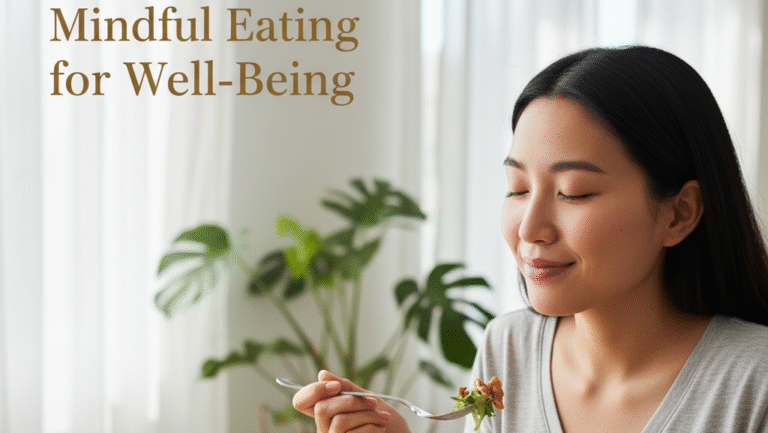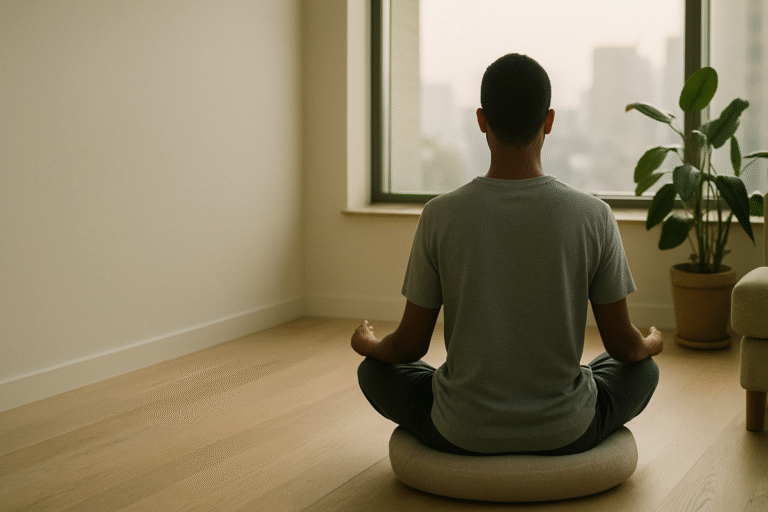Using Mindfulness to Manage Anxiety: A Practical, Compassionate Guide

Key Takeaways for Using Mindfulness to Manage Anxiety
- You don’t have to stop thoughts; you only need to notice and return.
- Small, frequent practices (2–5 minutes) beat long, rare sessions.
- Grounding and breath work offer rapid relief during anxiety spikes.
- Body awareness is an early-warning system, catch tension sooner, de-escalate faster.
- Cognitive defusion (“I’m having the thought that…”) reduces the power of worry.
- Self-kindness is a technique, not a luxury; it steadies the nervous system.
- Pair mindfulness with professional support when anxiety is severe.
- Make it a habit with “when-then” cues and simple daily bookends.
Introduction to Using Mindfulness to Manage Anxiety
Anxiety can feel like your mind has its foot stuck on the accelerator, racing thoughts, a tight chest, a churning stomach, and the uneasy sense that something’s wrong. Mindfulness is a powerful way to ease off that pedal. Instead of wrestling with thoughts or trying to “think your way out” of feelings, mindfulness helps you shift attention to the present moment, meet your experience with curiosity rather than judgment, and soften the body’s stress response. Over time, you learn that anxious thoughts are events in the mind, not orders you must obey. This guide expands the core ideas and gives you step-by-step practices, “SOS” tools for spikes of anxiety, and a simple plan to build a realistic daily habit.
Why Mindfulness Helps with Anxiety
1) It reduces rumination and worry
Anxious minds love to time-travel: replaying the past or pre-living the future. Mindfulness teaches your attention to land (and re-land) on what’s happening now. When you notice you’ve slipped into “what if” loops, you don’t scold yourself; you simply guide your focus back, again and again. That gentle redirection weakens the grip of worry and strengthens your “attention muscle” so you spend less time spiralling.
2) It increases awareness of body sensations
Anxiety often announces itself through the body: shoulders up to your ears, clenched jaw, fluttery belly. When you learn to spot these early signals, you can respond sooner, loosening your posture, lengthening your exhale, or doing a quick body scan before the worry escalates.
3) It changes your relationship with thoughts
Mindfulness doesn’t argue with thoughts; it introduces space around them. “I’m having the thought that I’m going to mess this up” lands very differently from “I’m going to mess this up.” That tiny phrase (“I’m having the thought that…”) is cognitive defusion in action. Thoughts are seen, labelled, and allowed to pass like clouds across a wide sky.
4) It calms the nervous system
Slow, steady, present-moment breathing and anchored attention signal safety to your body. Think of it as switching from “fight-or-flight” to “rest-and-replenish.” The more often you visit that calmer state, the easier it is for your system to find it again.
5) It improves emotional regulation
Mindfulness invites you to feel feelings without fusing with them. You acknowledge, “Nerves are here,” and notice where they live in your body. Instead of bracing against the feeling, you hold it with kindness. Paradoxically, allowing makes it easier to let go.
Core Mindfulness Techniques (With When & How to Use Them)
You don’t need to master them all. Try a few, notice what helps, and build from there.
1) Mindful Breathing (Anchor Practice)
How: Sit or lie comfortably. Soften your gaze or close your eyes. Notice the sensations of breathing from the tip of your nose to the rise and fall of your chest or belly. When your mind wanders (it will), gently return to the breath.
Pro tip: Extend the exhale slightly (e.g., inhale for 4, exhale for 6) to nudge the body toward calm.
When: Daily (start with 5–10 minutes) and anytime you feel keyed up.
2) Body Scan Meditation (Release Tension)
How: Move attention slowly from toes to head. At each region, notice sensation (pressure, warmth, pulsing). If you meet discomfort, acknowledge it and breathe around it, softening if possible.
Pro tip: Don’t chase relaxation; chase accuracy. Simply report what’s there.
When: Evening wind-down, post-work transition, or whenever you feel “in your head.”
3) Mindful Walking (Move the Energy)
How: Walk a little slower than usual. Feel the contact of your feet with the ground. Notice the swing of your arms, the cadence of steps, and the sounds around you.
Pro tip: If thoughts grab you, label “thinking” and return to the soles of your feet.
When: Midday reset, between meetings, or whenever sitting meditation feels tough.
4) Mindful Eating (Rebuild Calm with Routine)
How: Choose a snack or a few bites of your meal. Study its colour, texture, and smell. Take a slow bite and track the flavour and texture as they change. Put the utensil down between bites.
Pro tip: Switch off screens; let your senses lead.
When: One meal a day or the first three bites of any meal.
5) Observing Thoughts (Cognitive Defusion)
How: Notice an anxious thought and name it: “planning,” “catastrophizing,” “self-doubt.” Imagine placing the thought on a leaf floating down a stream or seeing it as subtitles on a screen.
Pro tip: Use, “I’m noticing I’m having the thought that…” to create room.
When: During worry spirals, before sleep, or ahead of a stressful event.
6) Loving-Kindness (Metta) (Soften Self-Criticism)
How: Silently repeat phrases of goodwill: “May I be safe. May I be at ease. May I meet this moment with kindness.” Extend to a loved one, a neutral person, a difficult person, and all beings.
Pro tip: If directing kindness to yourself is hard, begin with someone you naturally care for, then circle back to you.
When: After a tough conversation, when shame or self-judgment shows up, or as a gentle daily practice.
7) The RAIN Method (A Four-Step Check-In)
How:
R — Recognise what’s here (“This is anxiety”).
A — Allow the experience (“This is allowed to be here”).
I — Investigate with curiosity (Where do I feel it? What does it need?).
N — Nurture with kindness (a hand over the heart, a reassuring phrase).
Pro tip: Keep each step short; don’t turn it into analysis.
When: During an anxiety swell, after a trigger, or when you feel stuck.
8) STOP Skill (Micro-Pause)
How:
Stop.
Take a breath.
Observe body, thoughts, and urges.
Proceed with one small wise action.
Pro tip: Put “STOP” on a sticky note near your screen as a cue.
When: Before replying to difficult emails, entering a meeting, or giving feedback.
9) Box Breathing (Evening the System)
How: Inhale for 4, hold for 4, exhale for 4, hold for 4. Repeat 4–6 cycles.
Pro tip: If breath holds feel uncomfortable, skip the holds and just even the breaths.
When: Pre-presentation, in waiting rooms, or to steady nerves at bedtime.
10) 5-4-3-2-1 Grounding (Sensory Reset)
How: Name 5 things you can see, 4 you can feel, 3 you can hear, 2 you can smell, 1 you can taste (or a pleasant taste memory).
Pro tip: Whisper the list to yourself to anchor attention.
When: Sudden spikes of anxiety, panic sensations, or when you feel dissociated.
11) Urge Surfing (Riding Out Waves)
How: When an urge hits (to avoid, to check, to reassure), picture it as a wave. Breathe and ride it, noticing its crest, linger, and fall. Your job isn’t to stop it, only to not act on it.
Pro tip: Time the wave for 60–90 seconds. Most urges peak and pass within that window.
When: Compulsive checking, reassurance seeking, or avoiding tasks.
12) Compassionate Touch (Physiological Soother)
How: Place a warm palm on your chest or cheek, or hold your forearm. Feel the pressure and warmth. Offer a simple phrase: “It’s okay to feel this.”
Pro tip: It’s surprisingly effective; you’re signalling safety to your nervous system.
When: Any time emotions feel big or you’re tempted to self-criticise.
Integrating Mindfulness into Real Life (Without Making It a Chore)
Start small (and stack the habit)
Two minutes count. Attach practice to something you already do: after you boil the kettle, before you open your laptop, or the moment you park the car. Consistency beats intensity.
Use “when-then” plans
- When I sit at my desk, then I’ll do three box-breathing cycles.
- When I notice jaw tension, then I’ll drop my shoulders and lengthen my exhale.
- When I walk to the loo, then I’ll do mindful steps there and back.
Create mindful bookends for the day
- Morning (3–5 minutes): One minute of breathing, quick body scan, set a gentle intention: “Today, I’ll meet stress with one deep breath.”
- Evening (5 minutes): Body scan, note three things you appreciated, and a compassionate phrase for yourself.
“Micro-practices” you can sneak into busy days
- Waiting for a page to load: watch two full breaths.
- Before answering a message: STOP skill.
- Walking to the kitchen: mindful feet.
- Drinking water: feel the coolness, the swallow, the exhale.
A Simple 7-Day Starter Plan
Day 1: Breath & Body (5–7 minutes)
Two minutes of mindful breathing + three-minute body scan. Note one sensation without judgment.
Day 2: Labelling Thoughts (5 minutes)
Sit quietly and label mental events “planning,” “worrying,” “remembering.” Return to breath.
Day 3: Mindful Walking (5–10 minutes)
Slow walk, attention to your feet. If thoughts grab you, return to step sensations.
Day 4: RAIN (5–7 minutes)
Pick one mild anxious moment and walk through Recognise, Allow, Investigate, Nurture.
Day 5: Loving-Kindness (5 minutes)
Offer phrases of goodwill to yourself and one other person.
Day 6: 5-4-3-2-1 Grounding (3 minutes)
Practice the sensory reset once during the day; use it during a stress spike if one arises.
Day 7: Mix & Reflect (10 minutes)
Blend two practices you liked. Journal three lines: What helped? What got in the way? What’s one tweak for next week?
Repeat the week, nudging durations up by 1–2 minutes if it feels natural.
An “SOS” Plan for Sudden Anxiety Surges
When anxiety spikes, you don’t need a whole meditation session. Use this rapid sequence:
- Name it: “This is a surge of anxiety.”
- Drop anchor: Feet on the floor, notice contact points (heels, seat, back).
- Breathe low and slow: Inhale through the nose, longer exhale through the mouth (4 in, 6 out) for 1–2 minutes.
- Sense the room: Do a quick 5-4-3-2-1.
- Choose one next step: Drink water, step outside for 60 seconds of fresh air, or send the message you’ve been avoiding.
Write this plan on a small card or in your phone so it’s there when you need it.
Common Roadblocks (and Friendly Fixes)
“My mind won’t stop racing.”
That’s fine, racing is what busy minds do. Your job isn’t to stop thoughts; it’s to notice and return. Every return is a rep in the mindfulness gym.
“I don’t have time.”
You have pauses built into your day: the kettle boils, the app loads, the lift arrives. Turn those into practice windows. Two minutes, many times, add up.
“I tried once; it didn’t work.”
Mindfulness is a skill, not a switch. The early wins are subtle: a tiny gap before reacting, slightly easier sleep onset, a little less muscle bracing. Keep going.
“Mindfulness makes me feel more anxious.”
Sometimes turning toward sensations can feel intense. If that happens, back off and choose a grounding practice with eyes open (5-4-3-2-1, mindful walking) or a shorter duration. You’re in charge of the dial.
“I keep judging myself for doing it ‘wrong.’”
Self-judgment is just another mental event. Label “judging,” place a hand on your chest, offer a kind phrase, and continue.
“I need reassurance constantly.”
Notice the urge for reassurance and try urge surfing for 60–90 seconds before you decide what to do. The goal isn’t to ban reassurance; it’s to build confidence that you can ride waves without it.
Mindful Journaling Prompts (Quick and Gentle)
- “Right now, I notice…” (write for 60 seconds without editing)
- “If anxiety could talk, it would say…”
- “One thing my body is asking for is…”
- “One kind sentence I can offer myself today is…”
Keep it brief. This isn’t an essay; it’s a check-in.
Putting Mindfulness Next to Therapy or Medication
Mindfulness pairs beautifully with many approaches, such as CBT, ACT, and more. Think of it as the foundation that helps you notice patterns sooner and use your coping tools more effectively. If you’re experiencing severe anxiety, panic that limits your day, or intrusive thoughts that feel overwhelming, please reach out to a qualified professional. Mindfulness is a strong ally, not a replacement for care.
Quick Reference: Pick-a-Practice by Situation
- Before a presentation: Box breathing (4-4-4-4) + STOP.
- Racing mind at bedtime: Body scan + longer exhale (4 in, 6–8 out).
- After an argument: RAIN + compassionate touch.
- Sunday scaries: Mindful walking outside + write one kind sentence to yourself.
- Overwhelm at your desk: 5-4-3-2-1 + choose one 5-minute task and start.
- Compulsive checking (email, socials): Urge surfing for 90 seconds, then decide.
A Few Friendly Reminders
- You can’t fail at mindfulness. If you noticed you were gone and came back, you did it.
- Be specific and small. “I’ll breathe mindfully for two minutes after lunch” works better than “I’ll be more mindful.”
- Let kindness lead. The tone you take with yourself matters as much as the technique. Curiosity over criticism, always.
Closing Thought
Anxiety tries to convince you that the only safe place is the future, where everything is controlled. Mindfulness invites you back to the one place you can live and choose: this breath, this step, this moment. With steady, gentle practice, you’ll find more room inside your day, room to pause, to choose, and to meet yourself with warmth. Start small, return often, and let each tiny act of attention be a vote for the calmer life you’re building.
FAQs about Using Mindfulness to Manage Anxiety
What is mindfulness, and how does it help anxiety?
Mindfulness is present-moment awareness with a non-judgmental attitude. It reduces rumination, softens the stress response, and gives you space to respond rather than react.
How many minutes a day should I practice?
Start with 2–5 minutes and build to 10–15. Consistency matters more than length.
Which technique works fastest during a spike of anxiety?
Try 5-4-3-2-1 grounding or box breathing (4-4-4-4). They anchor the senses and steady your breath within a minute or two.
What if my mind won’t stop racing?
That’s normal. Label “thinking,” then gently come back to your anchor (breath, feet, or sounds). Every return is progress.
Can mindfulness replace therapy or medication?
No. It’s a valuable complement. If anxiety significantly impairs daily life, consult a qualified professional.
How long before I notice results?
Many people feel small shifts like easier sleep onset or a brief pause before reacting within 1–2 weeks of daily practice.
I can’t sit still. Can I still practice?
Yes. Use mindful walking, standing meditation, or open-eyes practices like 5-4-3-2-1.
Will turning toward sensations make me more anxious?
It can feel intense at first. Scale the practice down (shorter, eyes open) or switch to grounding until you feel steadier.
What’s the difference between mindfulness and meditation?
Meditation is a formal practice; mindfulness is the quality you bring to any moment. Meditation trains mindfulness.
Does mindfulness help with sleep?
Yes. Gentle body scans and longer exhales (e.g., 4 in, 6–8 out) can calm arousal and prepare you for rest.
Which practices help with work stress?
Use STOP (Stop, Take a breath, Observe, Proceed) before tough emails, and do two minutes of box breathing between tasks.
Are apps useful?
They can be; look for clear beginner courses and short daily practices. Choose any app that you’ll actually use.




